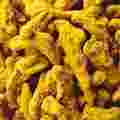Turmeric is a very important spice in India, which produces nearly the whole world’s crop and uses 80% of it. Turmeric usage dates back nearly 4000 years, to the Vedic culture in India, when turmeric was the principal spice and also of religious significance. In today’s India, turmeric is still added to nearly every dish, be it meat or vegetables. I found the largest quantities of it in boiled lentils (see also dill) or potatoes. Furthermore, it appears in rice dishes (pullao), although turmeric-dyed rice is not very common in India, which might surprise people who consider curry rice «typical Indian». Still, turmeric is part of all curry powders (see curry leaves for more information on this Anglo-Indian spice mixture). Due to Indian influence, turmeric has also made its way to the cuisine of Ethiopia (see long pepper).
In South East Asia, the fresh spice is much preferred to the dried. In Thailand, the fresh rhizome is grated and added to curry dishes; it is also part of the yellow curry paste (see coconut for more on Thai curries and curry pastes).
Origin
Because of ancient trade, the origin of turmeric cannot accurately be reconstructed; probably South East Asia or South Asia. A related species, C. xanthorrhiza, grows on Jawa, where it is called temu lawak; in taste, it is equivalent to C. longa.
Sensory quality
In fresh state, the rootstock has an aromatic and spicy fragrance, which by drying gives way to a more medicinal aroma. On storing, the smell rather quickly changes to earthy and unpleasant. Similarly, the colour of ground turmeric tends to fade if the spice is stored too long.

